|

THE SIERRA WESTERN
& SANTA FE RR

PROTOTYPICAL OPERATIONS ON THE
SIERRA WESTERN & SANTA FE
The Sierra Western & Santa Fe was designed to be operated in a prototypical manner, as if it were a real railroad. Much research and planning went into the track design to provide realistic traffic movement. Trains will have a job to do, instead of simply 'running in circles'. Regular operating sessions will be conducted where 10 to 20 model railroaders will work together to get the trains moving and products shipped.
As part of these operating sessions shipment orders will be generated to send products to and from industries on the layout. Yard crews will make up the trains by classifying the freight cars into groups, called 'blocks', to make it easier for the train crews to switch the cars at their destinations. Train crews will include an engineer, who will operate the train, and a conductor who will manage the delivery and pickup of freight on their route. A dispatcher will control traffic on the mainline to allow efficient movement of the several trains needed to handle all the freight being moved.

PART I
Pictured here are images taken from our first operating session held on April 4, 1998.
Click on thumbnail to see full size picture.
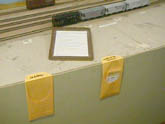 |
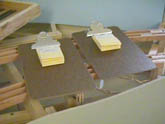
|
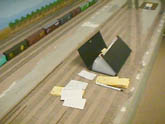
|
| Shown here is a clipboard with train instructions and the temporary card pockets attached to the layout's front edge. These will be replaced by permanent pockets in the future. |
Clipboards with car cards ready for the next train. Each car in the train has a car card. The conductor would be given the clipboard corresponding to his train when he came on duty. |
The yellow items are the car cards, one for each car on the layout, and the white items are the car waybills. The car cards identify car numbers and car types, and the waybills identify required car types and destinations, and are inserted in the card cards. The folder holds extra cards for cars not on the layout |
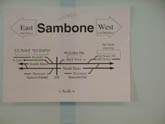
|
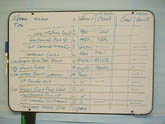
|
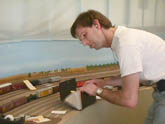
|
| A temporary track diagram is tacked up at each town or switching area to help the crew locate the industries that need to be worked. These will eventually be in a permanent form. |
The sign-up board. All trains are listed and crews sign up for the next one available. |
Mark Kosenski pulling cards to match the cars to be used in our first operating session. In Mark's ear is the ear speaker/microphone attached to his two-way communication radio. The radios allow the crews to communicate with each other. |
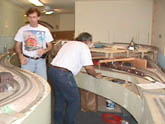 |
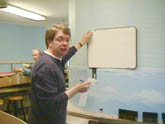 |
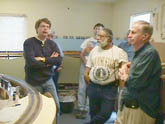 |
| Mark and Ron Orlando (right) are setting up trains in the lower level staging yard prior to the start of the operating session.
|
Byron Henderson entering the train assignments on the call board. Byron volunteered to organize and set up our session. |
Going over the crew sign-in instructions. From left to right: Byron, Larry Moseley (behind Byron), Mark behind Ron , Gary Zaro mostly hidden behind Ray Mayle.
|
|